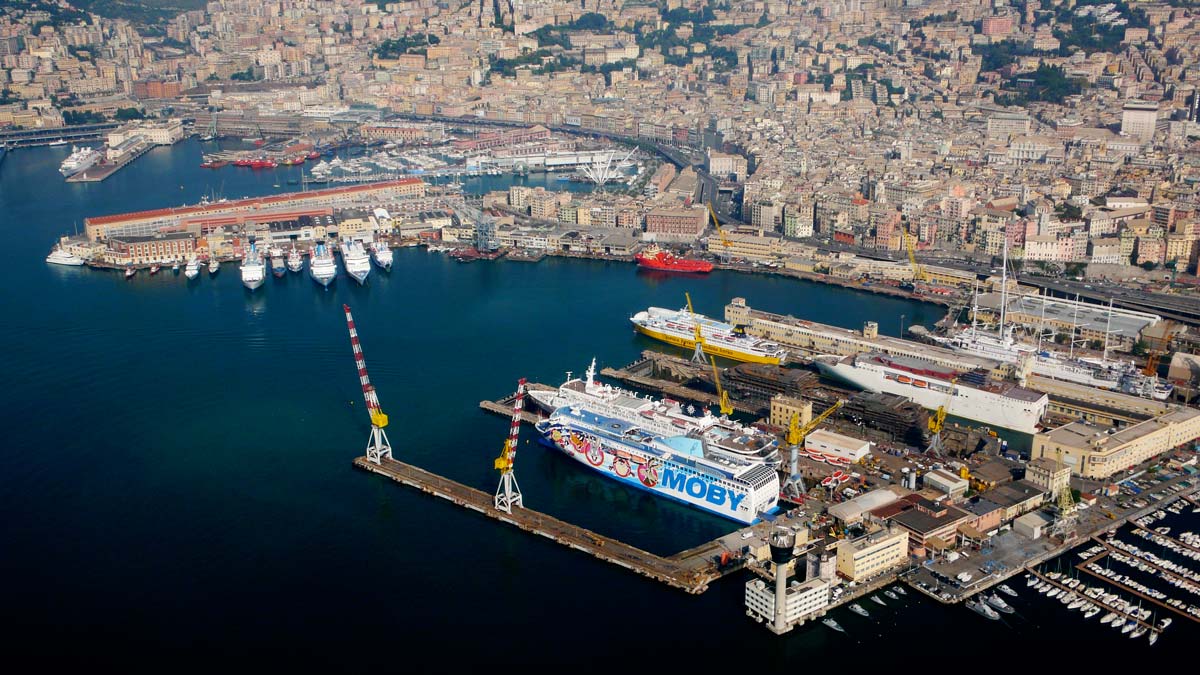Redesign of the Genoa Waterfront. Initial design and dimensioning of the maritime works. Application of mathematical models for the calculation of wave patterns and internal agitation wave.
Client: Port Authority of Genoa
Period of implementation: 2004-2006
Total value of works: Not available
Value of our services: Euro 323.434,17
Description
The work, part of the Master Plan offered to the City of Genoa by Arch. Renzo Piano, turns out to be a contribution to the cultural wealth of opportunities for the future urban, port, industrial and social development of the city itself. The Master Plan does not consist in a project, but in an overview that leaves plenty of room for the development of interventions, as long as they do not contrast with it excessively.
The key elements of the representation are summarized below.
The Airport Island
The basic choice underlying this new vision of the Port of Genoa is to shift the airport runway towards the sea, onto an artificial island, located opposite the existing runway, and linked to the shore by a tunnel, partly underground and partly under water. The new airport island will be approximately 3,620 metres long and approximately 390 metres wide; these measurements will ensure that the new airport comes in Class D, and thus ensure an increase in flight traffic of approximately 30% with respect to the current rate. This new island area will be made by using a mixed structure, basically consisting of reinforced concrete piles and caissons.
New Port of Multedo and Sestri Ponente
The planned conversion of the airport runway to port use will allow for the creation on its western end a new oil tanker docking zone, with the conversion of the docks previously used for this purpose into a tourist marina for around 1,500 boats, and as areas to be assigned to Fincantieri for developing its activities. The inlet forming the mouth of the Chiaravagna torrent would then be partially filled and redeveloped as a public park, to be connected with the large park on the Erzelli hill.
Harbor in Line
The analysis of the Port of Genoa has shown that the logical form characterizing the expansions of the infrastructure is a harbor in line developed following the course of the existing wharfs. The key to conversion, as already mentioned, lies in the shift of the airport towards the sea. The proposed idea is for a virtually uninterrupted development of wharfs for approximately 8 km and implementation of the necessary surfaces on the back. The straight layout of the new port will finally attract the big post-panama ships that are currently unable to use the port in Genoa.
Renovation of the Port of Voltri
The western side of the great filling with which it was made the Port of Voltri looks like a piece of land in the great state of decay. It is proposed, therefore, to extend to that area the reclamation and resettlement in public parks already embarked on the buffer zone, creating an underground pipeline that allows the circulation of the waters of the channel of calm, almost stagnated, and the sea open. Also in this area you could find accommodation a small harbor for fishing boats and its fish market.
The Shipyard Island
Ship building is a highly important and constantly evolving industrial sector where continuity must be guaranteed. The areas currently occupied by shipbuilding are strategic for completing the process of renovation of the town’s seafront. In order to solve this critical aspect, the construction of an artificial island was proposed, with the same technologies provided for the Airport Island, to be positioned opposite the Sampierdarena Basin in the stretch between Ponte Libia and Ponte Rubattino. This will also be connected on land through an underwater tunnel wide enough to guarantee access to heavy vehicles and will be protected from the open sea by new breakwaters. The Island will be approximately 2 km long and 150 m wide, with an overall area of approximately 300,000 m2. The dry docks will be built at the ends of the Island.
The ancient port
One of the problems affecting the efficiency of the historic port was the unreliability of the water body, particularly insecure because of the gulf too wide, unable to offer adequate natural protection. This problem was solved in 1905 with the completion of the breakwater, which resulted in the stagnation of the water. To cope with such problems, therefore, it has been proposed the construction of a pipeline system crossing of all the moles in such a way as to create recirculation of natural waters.
New Urban Waterfront between the Old Pier and the Fair
La proposta di trasferimento dei cantieri consentirebbe la creazione di un grande porto turistico per la nautica da diporto ottenuta riconfigurando Calata Gedda e l’allineamento con Calata Boccardo Calata Grazie in modo da collegare in linea retta per la zona di Porta Siberia con l’ex Stella batteria. In questo modo si ottiene una passeggiata lungo il mare, che inizia dal molo, con percorso continuo, si arriva a Boccadasse.
Once the Overpass is replaced with the underwater tunnel, a study could then be made of the effective connection between the new waterfront and Via Madre di Dio, the Sarzano Hill and the city historical centre. The dry docks could be almost fully maintained to initially allow a gradual transfer of the shipbuilding activities, and then the docking of old ships to be displayed for hotel use.
In particular it has been employed a mathematical model finite element that solves the equation of weak sloping seabed for monochromatic waves. Through this model it was possible to properly take into account both the effects caused by changes in the seabed in front of the harbor (refraction, diffraction inside, shoaling and wave breaking), and the effects of diffraction and reflection, induced by the presence of obstacles emerging (vertical walls, anti-reflective or absorbent structures, sloping walls). Numerical simulations were carried out considering the periods and directions of origin provided by the statistical frequent and extreme scenarios previously determined.




